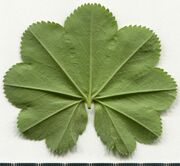Biology:Alchemilla vulgaris
| Lady's mantle | |
|---|---|

| |
| Scientific classification | |
| Kingdom: | Plantae |
| Clade: | Tracheophytes |
| Clade: | Angiosperms |
| Clade: | Eudicots |
| Clade: | Rosids |
| Order: | Rosales |
| Family: | Rosaceae |
| Genus: | Alchemilla |
| Species: | A. vulgaris
|
| Binomial name | |
| Alchemilla vulgaris | |
Alchemilla vulgaris, common name Lady's mantle, is an herbaceous perennial plant in Europe and Greenland.[1] These perennial wildflowers, members of the rose family, are sometimes grown in gardens - mainly for their leaves, which collect sparkling water droplets.
Lady's mantle is commonly seen in unimproved or lightly fertilized grassland, on roadside verges and banks, in chalk downland and on mountain slopes.
Synonyms:
- Alchemilla acutangula Buser[2]
- Alchemilla acutiloba Opiz[2]
- Alchemilla latifolia Salisb.[2]
- Alchemilla pontica (Buser) K.Malý[2]
- Potentilla acutiloba (Opiz) Christenh. & Väre[2]
Identification
The distinctively corrugated and lobed (5 to 11 lobes with the upper leaves having fewer) kidney-shaped to semicircular leaves of Alchemilla make identification to genus level fairly straightforward.
The yellowish-green flowers form clusters. Each individual flower is typically 3mm in diameter, with no true petals but a four-lobed epicalyx, four sepals and usually four but sometimes five stamens.
In Britain and Ireland the tiny flowers of Alchemilla vulgaris can be seen from June through to September.
Alchemilla mollis, a rather larger species but otherwise very similar, is quite a common garden escape that sometimes appears in hedgerows and on unkempt grassland.[3]
Other common names for Lady's Mantle are Nine Hooks, Bear's Foot, or Lion's Foot.[4]
Species interactions
Alchemilla vulgaris is a known host to a least three species of fungi, Coleroa alchemillae, Phoma herbarum and Ramularia aplospora.[5]
References
- ↑ Encyclopedia of Life. "Details for: Alchemilla vulgaris". Encyclopedia of Life. http://eol.org/pages/632883/. Retrieved 2013-07-23.
- ↑ 2.0 2.1 2.2 2.3 2.4 "Alchemilla vulgaris L. | Plants of the World Online | Kew Science" (in en). https://powo.science.kew.org/taxon/urn:lsid:ipni.org:names:721079-1.
- ↑ "Alchemilla vulgaris, Lady's Mantle: identification, distribution, habitat". http://www.first-nature.com/flowers/alchemilla-vulgaris.php.
- ↑ "Lady's Mantle Benefits (Alchemilla Vulgaris), Dosage, And Side Effects". http://health.in4mnation.com/ladys-mantle-benefits-alchemilla-vulgaris/.
- ↑ Helgi Hallgrímsson & Guðríður Gyða Eyjólfsdóttir (2004). Íslenskt sveppatal I - smásveppir [Checklist of Icelandic Fungi I - Microfungi. Fjölrit Náttúrufræðistofnunar. Náttúrufræðistofnun Íslands [Icelandic Institute of Natural History]. ISSN 1027-832X
Wikidata ☰ Q160189 entry
 |



